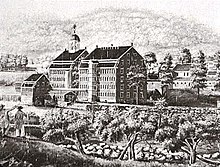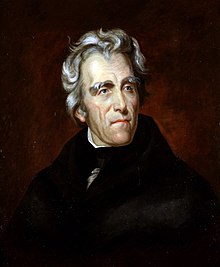| Revision as of 08:02, 2 September 2009 edit198.187.174.15 (talk)No edit summary← Previous edit | Revision as of 13:27, 2 September 2009 edit undoGoparkit (talk | contribs)2 edits →ArchitectureNext edit → | ||
| Line 95: | Line 95: | ||
| *] | *] | ||
| *Sweet Briar Plantation located in ]<ref>http://www.tusculum.sbc.edu/Teaching/sbplantation/sbplantation_print_lesson.pdf</ref> | *Sweet Briar Plantation located in ]<ref>http://www.tusculum.sbc.edu/Teaching/sbplantation/sbplantation_print_lesson.pdf</ref> | ||
| *Bellevue Plantation located in ] one of the most unusually designed plantations in Georgia. The main house was built of tabby on the first floor and cedar wood on the second floor. It was built in the shape of an anchor by John Floyd for his father Charles Floyd. The tabby walls are all that remain of the plantation today. | |||
| ==See also== | ==See also== | ||
Revision as of 13:27, 2 September 2009

The Antebellum Age (from the Latin ante, "before," and bellum, "war") was the time period in America from after the birth of the United States to the start of the American Civil War The Antebellum Age was a time of great transition because of the industrial revolution in America. It also was a time of growth in slavery in the American South. It was a phase in American history when America spread towards the west coast which among historians is generally referred to as "Westward Expansion".
Romanticism
There was a land of Cavaliers and Cotton Fields called the "Old South." Here in this pretty world, Gallantry took its last bow. Here was the last ever to be seen of Knights and their Ladies Fair, of Master and of Slave. Look for it only in books, for it is no more than a dream remembered, a Civilization gone with the wind...
- — From the opening of the film Gone with the Wind (1939)
While most western civilizations mark an important turning point during the period of the 1800s due to the Industrial Revolution, those who romanticize the Antebellum South credit the widespread destruction of Sherman's March to the Sea from Atlanta to the Atlantic Ocean and the military occupation of the defeated Confederacy by Union forces during the period termed Reconstruction implemented in Florida, Tennessee, or the Trans-Mississippi states, instead.
More than any other single American work, Margaret Mitchell's 1936 novel, Gone with the Wind and the subsequent 1939 film, have permanently altered historical perspective and fixed a slanted popularized image of pre–Civil War American history and are good examples of the romanticized view. The romanticized view looks back on the Antebellum Period with sentimental nostalgia, as an idealized pre-industrial highly-structured genteel and stable agrarian society, in contrast to the anxiety and struggle of modern life. The issue of slavery is largely ignored in Gone with the Wind — although Mitchell does make a point of examining the relationship between the slaves and their masters on the southern plantations. Kentuckian,D. W. Griffith's 1915 film, The Birth of a Nation, romanticized the pre-war South in a very similar way
Economic expansion
Main article: Industrial RevolutionIn the Antebellum Age the United States rapidly expanded economically from an agrarian nation into an industrial power. Industrialization in America involved two important developments. First, transportation was expanded. Second, improvements were made to industrial processes such as the use of interchangeable parts and railroads to ship goods more quickly. The government helped protect American manufacturers by passing a protective tariff.
The American System
Main article: American SystemThe American System, developed by Henry Clay, proposed a national bank that would stabilize the currency and rein in risky state and local banks, federally supported internal improvements like canals and roads, high prices for the public land sold under the Northwest Ordinance to generate revenue, and a high tariff to protect industry so that it could develop without foreign competition and generate revenue for the federal government. This system became the backbone of federal economic policy during the Antebellum Age.
A National Bank
Main article: Bank of the United StatesAfter the Revolutionary War, the United States had a large war debt to France and others. The national banking system was also in disarray. State banks printed their own currency and the plethora of different notes made commerce difficult and time consuming. To solve the debt problem and to unify the nation under one currency, Alexander Hamilton proposed creating a Bank of the United States. In 1791, the United States Congress passed the bank's charter and George Washington signed it. To avoid any appearance of impropriety, the Bank of the United States was forbidden from buying government bonds, had a mandatory rotation of directors (very much like today's Federal Reserve), and could neither issue notes nor incur debts beyond its actual capitalization. The BUS, as the Bank of the United States is commonly referred to, was a private company. It was given a twenty year charter in 1791 that was due to expire in 1811. At that time, Congress had the option to renew the charter. This need for renewal made the bank more vulnerable to political pressure.
Westward Expansion
Internal improvements
The tariff
The growth of slavery

Religious revival
Charles G. Finney and the Second Great Awakening

The Second Great Awakening was a reprise of the First Great Awakening Led by the spellbinding Charles G. Finney, revivalism shifted to upstate New York and the Old Northwest. An example of the how the Second Great Awakening changed communities is the Rochester Revival of 1830. After prominent citizens became concerned with the city's poverty and absenteeism, they invited Finney to the city. For six months, the preacher, with the great help of his wife, Lydia, converted or reconverted with citywide prayer meetings. The wave of religious revival contributed to tremendous growth of the Methodist, Baptist, and other denominations.
The Trancendentalists
Main article: TranscendentalismPolitical changes
Jackson's Presidency
Main article: Andrew Jackson
The Second American Party System
Perfectionist reform and Utopiansim
Main article: UtopiaDuring the Antebellum Age, many utopian communities were founded upon the ideals of the Second Great Awakening. Most of these communities, like most utopias, failed. But some of them, most famously the Mormons, survive to this day.
Oneida
Main article: Oneida CommunityIn 1848, John Humphrey Noyes and fifty-one devoted followers founded a utopian community in Oneida, New York. Noyes believed that the act of final conversion led to absolute and complete release from sin. Though their sexual practices were unorthodox, the community prospered because Noyes opted for modern manufacturing. Eventually abandoning religion to become a joint-stock company, Oneida thrived for many years and continues today as a silverware company.
The Shakers
Main article: ShakersFounded by Mother Ann Lee, the Shakers peaked at around 6,000 in 1850 in communities from Maine to Kentucky. The Shakers condemned sexuality and demanded absolute celibacy. New members could only come from conversions, not children of current members.
The Mormons
Main article: MormonsSocietal reform
Temperance
Main article: Temperance
Heath and sexuality
Humanizing the asylum
Main article: Dorothea DixAbolition and womens' rights
The Abolition Movement
Main article: AbolitionismWomens' Rights
Main article: Women's rightsArchitecture
The term antebellum is also used to describe the architecture of the pre-war South. Many Southern plantation houses use this style, including:
- Monmouth Plantation : Natchez, Mississippi
- Boone Hall : near Charleston, South Carolina. Built in 1936, but in the antebellum style.
- The Hermitage (Tennessee)
- Longwood (Natchez, Mississippi)
- Nottoway Plantation
- Belle Grove Plantation : Considered to be the largest plantation house ever built in the South
- Orton Plantation
- Rosedown Plantation
- Oak Alley Plantation
- Belle Meade Plantation
- Waverly
- Carnton Plantation
- Waveland Plantation
- Rippavilla Plantation
- Rattle & Snap Plantation
- Shirley Plantation located on the James River in Charles City County, Virginia. The plantation is said to be the oldest family owned business in North America.
- Tara Plantation (Fictional, From Gone with the Wind)
- The Old Governor's Mansion
- Candon Hearth
- Sweet Briar Plantation located in Sweet Briar, Virginia
- Bellevue Plantation located in Camden County, Georgia one of the most unusually designed plantations in Georgia. The main house was built of tabby on the first floor and cedar wood on the second floor. It was built in the shape of an anchor by John Floyd for his father Charles Floyd. The tabby walls are all that remain of the plantation today.
See also
- History of the United States (1789-1849)
- History of the United States (1849-1865)
- Origins of the American Civil War
- Old South
- Ancien Regime
References
- http://www.library.hbs.edu/hc/wes/collections/labor/textiles/content/1001956083.html
- ^ The American People, Sixth Edition, published by Pearson Education Incorporated, copyright 2004
- http://americanhistory.about.com/od/industrialrev/a/indrevoverview.htm
- http://www.u-s-history.com/pages/h278.html
- http://www.ushistory.org/tour/tour_1bank.htm
- http://www.u-s-history.com/pages/h1091.html.
- http://www.nyhistory.com/central/oneida.htm
- http://www.pbs.org/wnet/ihas/icon/shakers.html
- http://www.essortment.com/all/theshakersreli_rggy.htm
- Welcome To Monmouth Plantation
- http://www.lexisnexis.com/documents/academic/upa_cis/2462_AnteBellSouthPlanSerK.pdf
- Old Governor’s Mansion
- http://www.tusculum.sbc.edu/Teaching/sbplantation/sbplantation_print_lesson.pdf